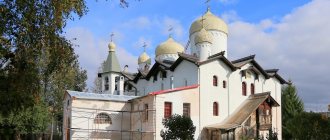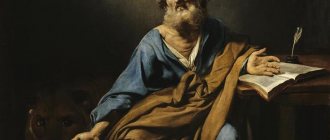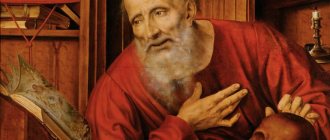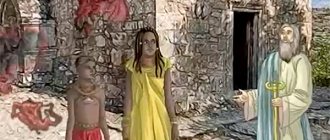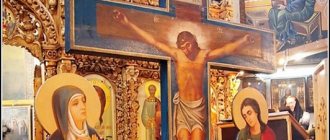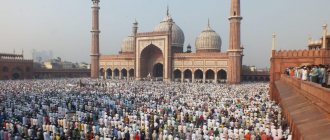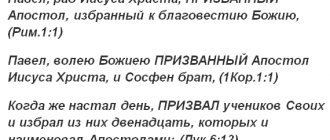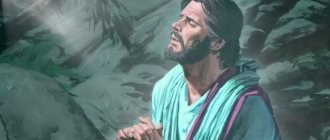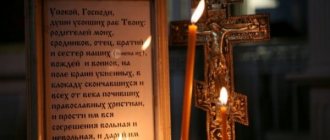Apostle Matthew in art
The holy apostle and evangelist Matthew was often depicted in icons and works of art.
Bartolozzi, Francesco. Apostle Matthew. Based on a drawing by Guercino (1591-1666).
Saint Matthew and the Angel (Guido Reni. 1635-1640)
Three paintings from the life of the Apostle by Caravaggio belong to the outstanding masterpieces of painting.
Caravaggio. Apostle Matthew and Angel
Matthew's symbol is an Angel standing behind him. But first they depicted the figure of a man, since the Gospel of Matthew begins with the genealogy of Christ as a man.
Apostle and Evangelist Matthew and Apostle Matthias are different people
However, one should distinguish between the Apostle and Evangelist Matthew and the Apostle Matthias (lat. Matthias), since they are often confused. Apostle Levi Matthew was one of the first to be called, and Matthias was the last. The Apostle Matthias (August 9) by lot took his place among the 12 apostles, instead of the fallen Judas Iscariot. Before that, he was one of the 70 disciples of Jesus.
Apostle and Evangelist Matthew
To better understand the story, let's explain some words that appear frequently in the New Testament.
A publican is a person appointed by the Roman procurator to collect taxes from the Jews (in the modern sense, a customs officer). Publicans usually farmed out the collection of these duties. In addition, they used all possible measures to obtain the greatest benefits for themselves. As self-interested and arrogant agents of the Romans, publicans were considered by the Jews not only to be traitors, but also traitors to their country and the Lord God. Sinner, pagan and publican - they meant the same thing. Firstly, talking to them was considered a sin. Secondly, to treat them is to defile oneself. But even among them there were good and God-fearing people.
The Pharisees are one of the Jewish sects that appeared in the 2nd and 3rd centuries. BC The Pharisees (special, separated) received their name from the fact that they tried to distinguish themselves by their special zeal for the law.
Meeting Christ
And so the Lord fixed His Divine gaze on this despised publican. One day, during His stay in Capernaum, the Lord left the city. Christ went to the sea, accompanied by the people. On the shore He saw Matthew sitting at the tollhouse (the place where duties and taxes were collected). And he said to him:
- Come after me!
The Calling of the Apostle Matthew
Hearing these words of the Lord not only with the ears of the body, but also with the eyes of the heart, the publican immediately rose from his place and, leaving everything, followed Christ. Matthew did not hesitate, was not surprised that the Great Teacher and Wonderworker was calling him, the despised publican; he heeded His words with all his heart and unquestioningly followed Christ. In joy, Matthew prepared a great meal in his house. The Lord did not refuse the invitation and entered Matthew’s house. And many of his neighbors, friends and acquaintances gathered at Matthew’s house. They are all publicans and sinners, but they reclined at the table with Jesus and His disciples. Some of the scribes and Pharisees also happened to be there.
Who are scribes
The Jews called scribes They were considered the most learned of the Jews, who explained the law and publicly taught the Old Testament. But in addition, they instructed the people in the law. They were called rabbis and teachers of the law; lawyers. They dealt with controversial issues, dubious cases and cases requiring knowledge of the law and practical experience. In addition, scribes and notaries who served in synagogues and Sanhedrins were considered scribes.
These learned Jews are presented in the New Testament as a special class, different from the Pharisees; but at the same time they are often united with the Pharisees, and put in contact with the bishops. Most of them were tied to the same legends. They, not understanding the spirit of the Law, interpreted it falsely. But at the same time they were blind leaders of the people, hypocritically only fulfilling the commandments for show. They did this for the sake of human glory. And they laid heavy burdens on others that they themselves did not fulfill.
It is not the healthy who need a doctor, but the sick
Seeing that the Lord does not disdain sinners and publicans, but reclines next to them, they grumbled and said to His disciples:
“How is it that He eats and drinks with publicans and sinners?”
But the Pharisees were only looking for an opportunity to reproach the Lord for something. They condemned the Savior for allegedly violating what is written in the psalm:
“Blessed is the man who does not walk in the counsel of the wicked.”
The Lord, hearing their words, said to them:
“ It is not the healthy who need a doctor, but the sick. I came not to call the righteous, but sinners to repentance ” (Matthew 9:13).
“Look,” says John Chrysostom, “how the Lord draws a completely opposite conclusion from the words of the Pharisees. They blame Him for communicating with tax collectors, but He, on the contrary, says that correcting such people is a very important, necessary and worthy matter of much praise.”
Matthew, realizing his sins, compensated those whom he had previously robbed fourfold. Moreover, he distributed the rest of his property to the poor and, together with the other apostles, followed Christ.
The apostle and evangelist Matthew records the sayings and miracles of Christ
Of all the twelve disciples, Matthew Levi was one of the most educated. But an illiterate person would not be hired as an official. Matthew's profession required him to be able to speak and write in different languages. Not only in Aramaic, but also in Greek, and possibly in Latin. And, following Christ, he diligently wrote down His sayings, which later formed the basis of the Gospel of Matthew.
Saint Matthew listened to the instructions of the Divine Teacher. First, I saw His countless miracles. Secondly, he went with the 12 apostles throughout Galilee and Judea preaching to “the lost sheep of the house of Israel” (Matthew 10:6). Thirdly, he witnessed the suffering, death and Resurrection of the Savior and His glorious Ascension into heaven.
Holy Apostle and Evangelist Matthew
